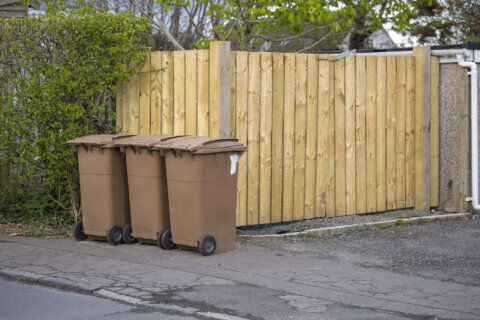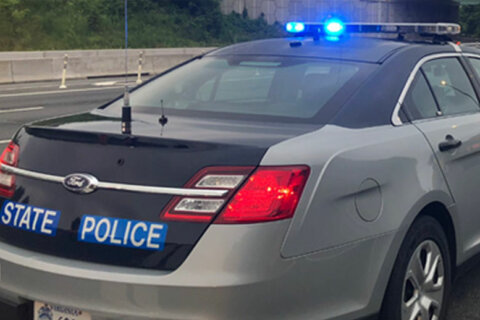This article was republished with permission from WTOP’s news partner InsideNoVa.com. Sign up for InsideNoVa.com’s free email subscription today.
Prince William County Public Schools’ cellphone pilot appears to be working well, school officials told the School Board at its Nov. 6 meeting, as the board considers what its formal cellphone policy will be in the new year.
The division expanded a cellphone pilot program to all middle and high schools this school year, restricting phone use.
The program mandates that middle school students have their cellphones off and away the entire school day, while high school students are required to abide by the off and away policy only during instructional class time.
The pilot program was expanded over the summer, around the same time Gov. Glenn Youngkin announced an executive order mandating cellphone-free education.
That order ultimately led to guidance issued by the Virginia Department of Education detailing what a cellphone-free education should look like, the primary element being phones must be off and away from bell-to-bell, or the entire school day.
A bell-to-bell policy includes lunch and time in between class periods.
Pilot program
The current cellphone pilot program has different guidelines for each school level.
For kindergarten through eighth-grade students, devices must be silenced and stored away during the school day. Dual-purpose watches are allowed, but wireless/cellular features must be turned off or in airplane mode. Devices are allowed on school buses if they do not district the driver, compromise safety or violate rules.
For high school students, devices must be silenced and stored away only during instructional periods. The same rules apply for dual-purpose watches. Devices and one earbud are allowed during lunch and hallway passing times, but use is prohibited in locker rooms and restrooms.
The pilot program provides exceptions to students who have disability accommodations through Section 504 plans or individualized education plans when necessary. Exceptions may be granted as part of a student’s health, safety or support plan when necessary.
Catherine Porter-Lucas, the associate superintendent for middle schools, also detailed for the School Board a “response matrix” that outlines consequences for students who are caught using cellphones during unauthorized times.
“Having the same responses and consequences across all schools has been the key to the success of our pilot,” Porter-Lucas said.
For students’ first cellphone infraction, the device is surrendered and returned at the end of the class period. The student also signs an acknowledgment form that’s recorded in the division’s student information system.
For a second infraction, the device is surrendered and locked in the main office and returned to the student at the end of the school day. A staff member also reaches out to a parent or guardian, and it is recorded again in the student information system.
When a student reaches a third infraction, the device is again surrendered and locked in the main office. The student is required to complete a healthy cellphone use module, and the parent or guardian must retrieve the device from the school. It’s documented as a referral in the division’s system, and the parent or guardian signs an acknowledgment of further consequences form.
“Based on our feedback, overall, family staff and students feel that the implementation of the new wireless device guidelines is going well, and our pilot schools are effectively implementing guidance,” Porter-Lucas said.
Recommendations
The division created a cellphone focus group consisting of school leaders, staff, high school students, parents and central office staff to review its policy. Based on the results of the pilot and surveys conducted by the focus group, division staff came up with two recommended options for a formal cellphone policy.
Option one recommends the following:
Elementary (Kindergarten through fifth grade)
- Cellphones or personal electronic communication devices must be turned off and stored away at all times while in the school building and on school grounds.
Middle (sixth-eighth grade)
- Cellphones and/or personal electronic communication devices must be turned off and stored away during the school day. Storage starts at the first tardy bell and ends at the dismissal bell.
High school (ninth-12th grade)
- Cellphones and personal electronic communication devices must be turned off and stored away during instructional time.
- Devices and one earbud (headphones) are allowed during lunch and hallway passing times. Use is prohibited in locker rooms and restrooms
Buses
- Cellphones and personal electronic communication devices are allowed on school buses if they do not distract the driver, compromise safety or violate the Prohibited Content and Use for All Students.
Field Trips
- Cellphones and personal electronic communication devices must be off and away during instructional field trips unless required as an instructional tool.
Staff expectations
- All staff communications with students shall comply with Regulation 503-1: Standards of Professional Conduct for all Employees.
- Staff should model the behavior of appropriate cellphone and personal electronic communication device use
Emergency protocols
- School-based staff supervising students will have access to a cellphone (if designated by the division) or classroom phone for emergencies
- Students should not use personal electronic communication devices during emergencies unless directed by staff for reunification purposes
- Family-based emergencies should be communicated to the front office. Prince William County Public Schools will define and communicate family-based emergencies and nonemergency drop-offs and procedures
- Division and school leaders will publicly share emergency communication protocols and processes, including training and reunification plans with families
For Option two, devices must be off and away from bell-to-bell for all students, including high schoolers.
Option two is the stricter policy of the two options and is also the option that would be in alignment with the Virginia Department of Education guidance.
Porter-Lucas told the School Board if option two is the preferred choice, the school division would request that the policy would go into effect in August at the start of the 2025-26 school year rather than by Jan. 1, the date which the state Department of Education guidance set for school division to implement policies.
Several high school students previously told InsideNoVa that option one — which largely mirrors the division’s pilot program — is their preferred option because it allows cellphone use at various points throughout the school day.
Almudena Latorre Melendez, a senior at C.D. Hylton High School, said she has a job and frequently needs to be updated on schedules and other details from her boss or coworkers.
A bell-to-bell cellphone policy would make those kinds of daily communications difficult, she said.
Next steps
At the School Board’s next meeting, board members will propose and discuss a policy of their choosing, which could be either of the options recommended by the division or an entirely different policy created by board members.
At the following meeting, scheduled currently for Dec. 4, School Board members will vote on the policy.
Ultimately, the school division told the School Board it would implement the policy the board passes, no matter what.
“Whichever direction that the board chooses to go with this policy, we will be fully prepared to implement it and enact the policy as written,” Superintendent LaTanya McDade said.







